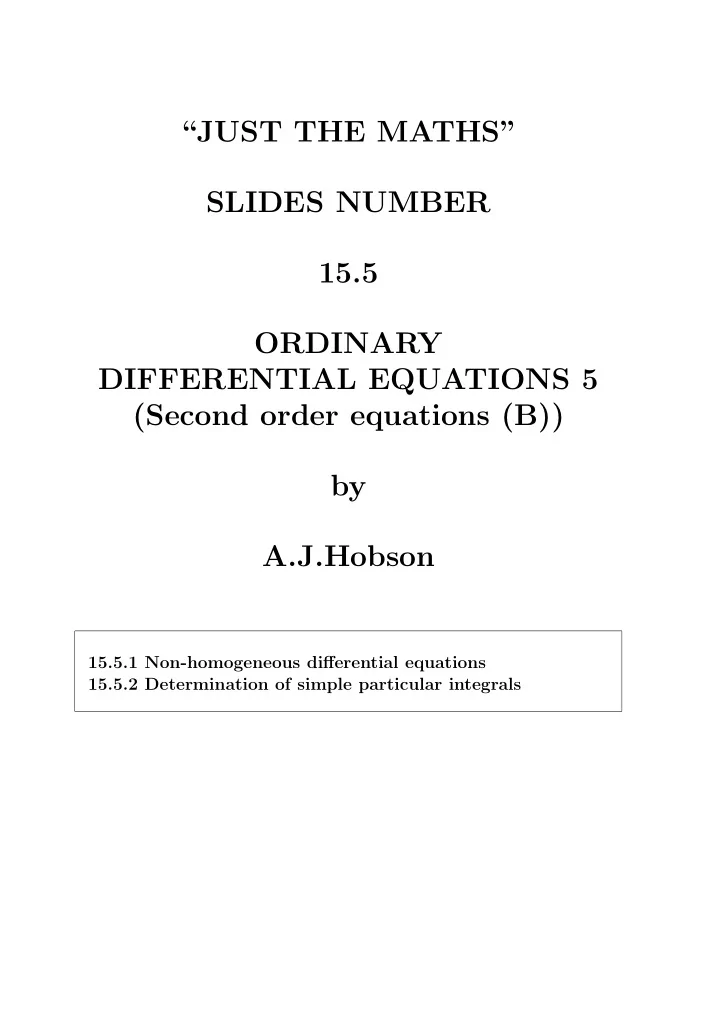

“JUST THE MATHS” SLIDES NUMBER 15.5 ORDINARY DIFFERENTIAL EQUATIONS 5 (Second order equations (B)) by A.J.Hobson 15.5.1 Non-homogeneous differential equations 15.5.2 Determination of simple particular integrals
UNIT 15.5 - ORDINARY DIFFERENTIAL EQUATIONS 5 SECOND ORDER EQUATIONS (B) 15.5.1 NON-HOMOGENEOUS DIFFERENTIAL EQUATIONS Here, we examine the solution of the second order linear differential equation a d 2 y d x 2 + b d y d x + cy = f ( x ) , in which a , b and c are constants, but f ( x ) is not identi- cally equal to zero. THE PARTICULAR INTEGRAL AND THE COMPLEMENTARY FUNCTION (i) Let y = u ( x ) be any particular solution of the differen- tial equation; that is, it contains no arbitrary constants. In the present context, we shall refer to such particular solutions as “particular integrals” . Systematic methods of finding particular integrals will be discussed later. 1
Since y = u ( x ) is a particular solution, a d 2 u d x 2 + b d u d x + cu = f ( x ) . (ii) Let the substitution y = u ( x ) + v ( x ) be made in the original differential equation to give a d 2 ( u + v ) + b d( u + v ) + c ( u + v ) = f ( x ) . d x 2 d x That is, a d 2 u d x + cu + a d 2 v d x 2 + b d u d x 2 + b d v d x + cv = f ( x ) . Hence, a d 2 v d x 2 + b d v d x + cv = 0 . Thus, v ( x ) is the general solution of the homogeneous differential equation whose auxiliary equation is am 2 + bm + c = 0 . In future, v ( x ) will be called the “complementary function” in the general solution of the original (non- homogeneous) differential equation. 2
The complementary function complements the particular integral to provide the general solution. Summary General Solution = Partic. Int. + Comp. Functn. 15.5.2 DETERMINATION OF SIMPLE PARTICULAR INTEGRALS (a) Particular integrals, when f ( x ) is a constant, k For the differential equation a d 2 y d x 2 + b d y d x + cy = k, k a particular integral will be y = c , since its first and second derivatives are both zero, while cy = k . EXAMPLE Determine the general solution of the differential equation d 2 y d x 2 + 7d y d x + 10 y = 20 . 3
Solution (i) By inspection, a particular integral is y = 2. (ii) The auxiliary equation is m 2 + 7 m + 10 = 0 or ( m + 2)( m + 5) = 0 , having solutions, m = − 2 and m = − 5. (iii) The complementary function is Ae − 2 x + Be − 5 x , where A and B are arbitrary constants. (iv) The general solution is y = 2 + Ae − 2 x + Be − 5 x . 4
(b) Particular integrals, when f ( x ) is of the form px + q . For the differential equation a d 2 y d x 2 + b d y d x + cy = px + q, it is possible to determine a particular integral by assum- ing one which has the same form as the right hand side. In this case, the particular integral is another expression consisting of a multiple of x and constant term. The method is illustrated by an example. EXAMPLE Determine the general solution of the differential equation d 2 y d x 2 − 11d y d x + 28 y = 84 x − 5 . 5
Solution (i) First, we assume a particular integral of the form y = αx + β. This implies that d x = α and d 2 y d y d x 2 = 0 . Substituting into the differential equation, − 11 α + 28( αx + β ) ≡ 84 x − 5 . Hence, 28 α = 84 and − 11 α + 28 β = − 5, giving α = 3 and β = 1. Thus the particular integral is y = 3 x + 1 . (ii) The auxiliary equation is m 2 − 11 m + 28 = 0 or ( m − 4)( m − 7) = 0 . 6
The solutions of the auxiliary equation are m = 4 and m = 7. (iii) The complementary function is Ae 4 x + Be 7 x , where A and B are arbitrary constants. (iv) The general solution is y = 3 x + 1 + Ae 4 x + Be 7 x . Note: In examples of the above types, the complementary func- tion must not be prefixed by “ y =”, since the given dif- ferential equation, as a whole, is not normally satisfied by the complementary function alone. 7
Recommend
More recommend